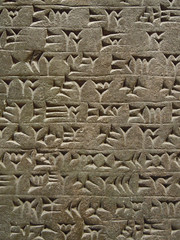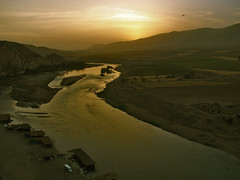From Hunting and Gathering to Civilizations, 2.5 million-1000 B.C.E.: Origins
Original from MrsBHatchTEACHER
| 12203846200 | hunting and gathering | Means of obtaining subsistence by humans before the mastery of sedentary agriculture; normally typical of tribal social organization |  | 0 |
| 12203846201 | civilization | Societies with reliance on sedentary agriculture, ability to produce food surpluses, and existence of nonfarming elites, along with merchant and manufacturing groups | 1 | |
| 12203846202 | neolithic | The New Stone Age between 8000 and 5000 B.C.E.; period in which adaptation of sedentary agriculture occurred; domestication of plants and animals accomplished |  | 2 |
| 12203846203 | nomadic societies | livestock hearding societies that do not have a permanent settlement. normally found on the fringes of civilized (urban) societies; commonly referred to as "barbarian" by civilized societies |  | 3 |
| 12203846204 | culture | Combination of ideas, objects, and patterns of behavior that result from human social interaction |  | 4 |
| 12203846205 | agrarian revolution | Occurred between 8000 and 5000 B.C.E.; transition from hunting and gathering to sedentary agriculture |  | 5 |
| 12203846206 | pastoralism | A nomadic agricultural lifestyle based on herding domesticated animals; tended to produce independent people capable of challenging sedentary agricultural societies |  | 6 |
| 12203846207 | Mesopotamia | Literally "between the rivers"; the civilization that arose in the alluvial plain of the Tigris-Euphrates river valleys |  | 7 |
| 12203846208 | potter's wheel | A technological advance in pottery making; invented circa 6000 B.C.E.; encouraged faster and higher-quality ceramic pottery products |  | 8 |
| 12203846209 | Sumerians | People who migrated into Mesopotamia circa 4000 B.C.E.; created the first civilization within the region; organized area into city-states |  | 9 |
| 12203846210 | cuneiform | A form of writing developed by the Sumerians using a wedge-shaped stylus and clay tablets |  | 10 |
| 12203846211 | city-state | A form of political organization typical of Mesopotamian civilization; consisted of agricultural hinterlands ruled by an urban-based king |  | 11 |
| 12203846212 | Babylonian Empire | Unified all of Mesopotamia circa 1800 B.C.E.; collapsed due to foreign invasion circa 1600 B.C.E. |  | 12 |
| 12203846213 | Hammurabi | The most important Babylonian ruler; responsible for codification of the law |  | 13 |
| 12203846214 | Pharaoh | The term used to denote the kings of ancient Egypt; the term, "great house" refers to the palace of the pharaohs |  | 14 |
| 12203846215 | pyramids | Monumental architecture typical of Old Kingdom Egypt; used as burial sites for pharaohs |  | 15 |
| 12203846216 | hieroglyphs | Form of writing developed in ancient Egypt; more pictorial than Mesopotamian cuneiform |  | 16 |
| 12203846217 | monotheism | The exclusive worship of one god; introduced by Jews into Middle Eastern civilization |  | 17 |
| 12203846218 | Aryans | Indo-European nomadic, warlike, pastorialists who replaced Harappan civilization |  | 18 |
| 12203846219 | Huanghe (Yellow) River Basin | Site of the development of sedentary agriculture in China |  | 19 |
| 12203846220 | Shang | 1st Chinese dynasty (after the legendary Xia) |  | 20 |
| 12203846221 | Oracles | Shamans or priests in Chinese society who foretold the future through interpreting animal bones cracked by heat; inscriptions on bones led to Chinese writing |  | 21 |
| 12203846222 | Big Geography | A term that draws attention to the global nature of world history. |  | 22 |
| 12203846223 | Paleolithic | The period that ended about 3,000 years after the end of the last Ice Age, it lasted until about 10,000 years ago. (Old Stone Age) The period of the Stone Age associated with the evolution of humans. It predates the Neolithic period. |  | 23 |
| 12203846224 | Human migration during Paleolithic era | movement of humans from Africa to Eurasia, Australia, and the Americas | 24 | |
| 12203846225 | eglitarian | equality among people (no social levels) | 25 | |
| 12203846226 | tools | Humans developed a wider range of ____ specially adapted to different environments from tropics to tundra | 26 | |
| 12203846227 | Neolithic Revolution | period of change from hunter-gatherer lifesyle to agricultural lifestyles associated with domestication, farming, and settlement |  | 27 |
| 12203846228 | patriarchy | father based/male dominated society |  | 28 |
| 12203846229 | climatic change | Permanent agricultural villages emerged first in the lands of the eastern Mediterranean, possibly as a response to what? | 29 | |
| 12203846230 | weapons | Pastoralists were often the developers and disseminators of of ____ and forms of transportation that transformed warfare in agrarian civilizations | 30 | |
| 12203846231 | horses | name one mode of new transportation by the pastoralists | 31 | |
| 12203846232 | art | Elites, both political and religious, promoted ____. | 32 | |
| 12203846233 | record-keeping systems | ___ arose independently in all early civilization sand subsequently were diffused | 33 | |
| 12203846234 | Nile River | This river flooded regularly. |  | 34 |
| 12203846235 | Tigris River | This river's floods were unpredictable. |  | 35 |
| 12203846236 | Mesopotamian | Unpredictable weather patterns affected the development of the _____ civilization. | 36 | |
| 12203846237 | Egyptian | _______art demonstrated little change for nearly 1000 years. | 37 | |
| 12203846238 | Euro diseases | Smallpox, measles, diphtheria, influenza, malaria, yellow fever and typhoid nearly wiped put entire indian villages | 38 | |
| 12203846239 | Spanish Silver | commercial and new global economic | 39 | |
| 12203846240 | cod hot spot | northern european in america | 40 | |
| 12203846241 | Confucianism | The system of ethics, education, and statesmanship taught by Confucius and his disciples, stressing love for humanity, ancestor worship, reverence for parents, and harmony in thought and conduct. | 41 | |
| 12203846242 | Doaism | Religion that teaches people to give up earthly desires in favor of nature | 42 | |
| 12203846243 | Legalism | A Chinese philosophy that was devoted to strengthen and expand the state through increased agricultural work and military service. | 43 |

